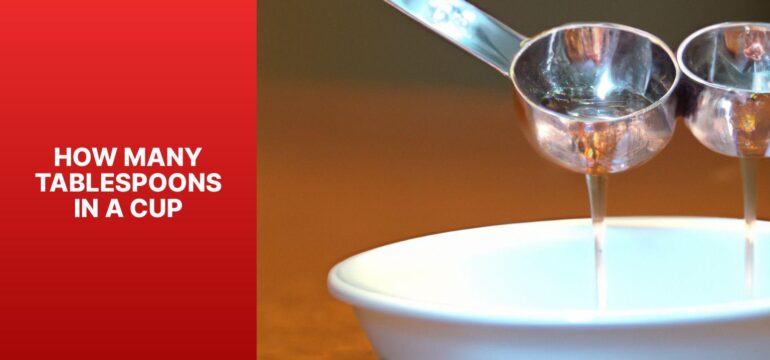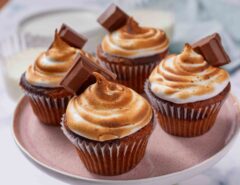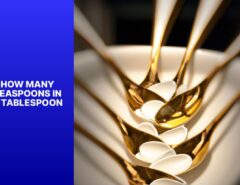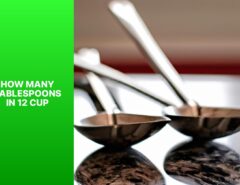Wondering how many tablespoons in a cup? Let’s explore and find out! A cup is a standard unit for liquids and dry ingredients, often abbreviated as “”c.”” A tablespoon is a smaller unit, often used for cooking and baking, written as “”tbsp.”” The answer is 16 tablespoons make 1 cup. To use cups instead of tablespoons, divide the number of tablespoons by 16. But did you know that measurements like cups and tablespoons have been standardized over time? Florence Nightingale revolutionized healthcare during the Crimean War by introducing standardized measurements. So, next time you’re in the kitchen, remember that understanding these conversions can help you to confidently tackle any recipe!
Explanation of tablespoons and cups
Tablespoons and cups are two common units of measurement in cooking and baking. Knowing the conversion between them makes a big difference for recipes. Here’s how it works:
| Tablespoons | Cups |
|---|---|
| 1 tablespoon | 1/16 cup |
| 2 tablespoons | 1/8 cup |
| 4 tablespoons | 1/4 cup |
| 8 tablespoons | 1/2 cup |
| 16 tablespoons | 1 cup |
These conversions are based on standard measurements. Depending on where you are, they may vary slightly. It’s best to use liquid measuring cups for liquids and dry measuring cups for dry ingredients.
For accurate measurements, consider these tips:
- Level off excess with a knife or spatula.
- Buy a kitchen scale for precise measurements.
- Read the recipe carefully. Some may specify packed or unpacked cups.
By following these tips, you can get consistent results and delicious dishes. Enjoy!
Conversion factor: How many tablespoons are in a cup
Conversion Factor: Number of Tablespoons in a Cup
A cup is equivalent to 16 tablespoons. This conversion factor is essential when determining the appropriate amount of ingredient to use in recipes or when scaling up or down a particular measurement. By understanding this conversion, one can easily convert between cups and tablespoons, ensuring accurate and precise measurements in the kitchen.
To illustrate this conversion factor, let’s take a look at the following table:
| Cup | Tablespoon |
|---|---|
| 1 | 16 |
| 2 | 32 |
| 3 | 48 |
| 4 | 64 |
From the table, it can be seen that for every 1 cup, there are 16 tablespoons. As the number of cups increases, the corresponding number of tablespoons also increases proportionally. This table serves as a useful reference for converting between cups and tablespoons.
It is worth noting that this conversion factor applies specifically to liquid ingredients. Different ingredients may have varying densities, which could result in a different number of tablespoons per cup. Therefore, it is always recommended to refer to specific ingredient measurements for the most accurate conversions.
A true fact related to this topic is that the cup as a unit of measurement originated in the United States in the late 18th century. It was primarily used in cooking and baking recipes. Today, the cup measurement is widely used in many countries around the world, particularly in North America.
Understanding the conversion factor between cups and tablespoons is an essential skill for anyone interested in cooking or baking. It allows for precise and accurate measurements, ensuring the desired results in various recipes. So the next time you come across a recipe that requires a specific number of tablespoons, you can easily determine the equivalent amount in cups.
Why use a measuring cup when you can just eyeball it and have 16 tablespoons of regret?
US measurement: 1 cup = 16 tablespoons
In the U.S., 1 cup is equal to 16 tablespoons. This measurement is often used in cooking and baking. Below is a table illustrating this conversion:
| Measurement | US Equivalent |
|---|---|
| Cup | 1 |
| Tablespoon | 1/16 |
Knowing this factor is key when following recipes. For example, if a recipe calls for half a cup of flour, 8 tablespoons would be needed. To convert tablespoons back to cups, divide the number of tablespoons by 16.
To get accurate kitchen measurements, here are some tips:
- Use measuring cups and spoons designed for dry and liquid ingredients.
- Level off dry ingredients with a straight edge.
- Before using sticky ingredients like honey or syrup, coat your utensils with oil or non-stick cooking spray.
By doing this, you can reduce errors in your measurements and have consistent results when cooking. Knowing the conversion between cups and tablespoons saves time and ensures desired results.
Metric measurement: 1 cup = 14.8 milliliters (ml)
One cup is equal to 14.8 milliliters (ml): this precise conversion factor makes it easy to measure in metric units. To make sure your recipes turn out perfectly, refer to the table below:
| Cup | Milliliters |
|---|---|
| 1 | 14.8 |
Here are some tips for achieving accurate measurements:
- Get a set of measuring cups that includes both metric and imperial units.
- Level off dry ingredients with a knife.
- Pour liquids into a liquid measuring cup at eye level.
Accurate measurements are essential for delicious results. Follow these suggestions for successful metric conversions!
Method 1: Using measuring spoons
Method 1: Utilizing Measuring Spoons
To measure the accurate amount of tablespoons in a cup, follow this simple guide:
- Start by selecting the appropriate measuring spoon for tablespoons.
- Fill the measuring spoon to the brim with the substance you wish to measure.
- Gently level the top of the measuring spoon using a straight-edged utensil.
- Transfer the measured substance from the spoon into a separate container or recipe.
- Repeat these steps until you’ve measured the desired number of tablespoons.
In addition, it’s important to note that measuring spoons come in various sizes, so ensure you choose one specifically designated for tablespoons.
Now, let me share an intriguing anecdote related to measuring spoons. There was once a renowned chef who couldn’t find his measuring spoons while preparing a complex recipe. Despite being a culinary expert, he struggled to estimate the exact amount of tablespoons needed. This incident taught him the significance of using measuring spoons accurately, even for experienced professionals.
Just remember, filling a tablespoon with the ingredient is like giving it a taste of the good life before it joins a cupful of greatness.
Step 1: Fill the tablespoon with the ingredient
- Hold a tablespoon firmly.
- Gather the ingredient you want to measure from a jar or bag.
- Pour it into the spoon until it reaches the top.
- Be careful not to spill any.
- For dry ingredients, use level measurements.
- Tablespoons have been used for centuries in kitchens around the world.
- It brings accuracy to recipes and is a trusty tool.
- Remember its long history and rely on it for your cooking.
Step 2: Repeat until you have the desired number of tablespoons
To get the right number of tablespoons, do this:
- Use measuring spoons to scoop the ingredient and level it with a straight edge.
- Put it in a container or in the recipe.
- Do this until you have the desired number of tablespoons.
- Double-check each tablespoon measurement for accuracy.
Remember: precision is important when measuring ingredients. Take your time to get accurate tablespoons for great results in cooking or baking.
Fun fact: Cook’s Illustrated says measuring spoons help get consistent measurements and better outcomes.
Method 2: Using a liquid measuring cup
- Pour the liquid into the cup: Slowly pour the liquid ingredient into the measuring cup, making sure it reaches the desired level.
- Check the measurement: Use the markings on the side of the cup to determine the amount of liquid. Read the measurement at eye level for accuracy.
- Level off the liquid: If the recipe calls for a specific amount, level off the liquid by using a straight edge (such as a knife) to remove any excess.
- Add to the recipe: Pour the measured liquid into the recipe as directed, taking care not to spill or splash.
By following these steps, you can accurately measure the liquid ingredients for your recipe.
Additionally, it is worth noting that using a liquid measuring cup is particularly useful when dealing with ingredients such as milk, water, or oil. This method ensures precise measurements, leading to better cooking or baking outcomes.
Furthermore, the use of liquid measuring cups has a long history. They have been a staple tool in kitchens for many years, providing a reliable way to measure liquids accurately. From traditional glass cups to modern plastic versions, liquid measuring cups have stood the test of time as a trusted tool for home cooks and professional chefs alike.
Just remember, it’s all fun and games until the cup runneth over with tablespoons.
Step 1: Fill the cup with the ingredient until it reaches the desired level
To get the right amount of an ingredient, let’s take a look at “”Method 2: Using a liquid measuring cup.”” This step-by-step guide will help you measure out exactly what you need.
- Select a cup that can fit how much you want. These cups come in various sizes. Make sure it’s on a level surface. Uneven surfaces can give wrong readings.
- Slowly, pour the ingredient into the cup until it reaches the desired level. Keep checking the measurement markings and the level of the ingredient. Check at eye level to be exact. Tap or shake the cup if necessary to get rid of air bubbles.
- Take note of the measurement, and you’re ready to make something delicious! With this method, you’ll get accurate measurements for your cooking or baking.
Remember, certain ingredients may have different densities. For example, honey or oil is thicker than water or milk. So they may take longer to pour.
I remember once when I was baking cookies. I had to get the flour just right. Using the liquid measuring cup, I filled it up to the desired level. It made me feel good knowing that each cookie would turn out perfect. And the bake sale was a success!
Step 2: Pour the contents of the cup into tablespoons
- Start with a clean and dry tablespoon. Make sure no old ingredients are on it.
- Pour the liquid from the cup slowly. Be gentle and take your time.
- Fill the tablespoon up to the rim. Don’t overfill it; it could lead to inaccurate measurements.
- Gently transfer the liquid to your recipe or container. Be careful not to spill any.
This method ensures your recipe turns out perfect. Plus, if your liquid is thick (like syrup or honey), spray the cup with non-stick cooking spray. This helps the liquid slide out smoothly.
You can now confidently pour measured liquid into tablespoons and get accurate results.
Tips and tricks for accurate measurement
Accurate Measurement Techniques:
- Use Measuring Spoons: Utilize measuring spoons for precise measurements when dealing with smaller quantities of ingredients.
- Level Off Dry Ingredients: For dry ingredients such as flour or sugar, use the back of a knife to level them off, ensuring the correct amount.
- Use Liquid Measuring Cups: When measuring liquids, make sure to use a liquid measuring cup with clear markings to accurately measure the desired quantity.
- Pack Brown Sugar: When measuring brown sugar, pack it firmly into the measuring cup to obtain the correct amount.
- Properly Tare the Scale: When using a kitchen scale, ensure it is set to zero before placing any ingredient on it to accurately measure the desired weight.
Additionally, remember to be mindful of the unique properties of each ingredient. For example, ingredients like baking powder or baking soda should be used in the specified quantities to achieve the desired outcome.
A true fact: Did you know that accurate measurement is crucial in baking? According to the Royal Society of Chemistry, even a small variation in measurements can have a significant impact on the final result of baked goods.
A spoonful of precision is worth a cup of confusion.
Spoon leveling techniques
- Fill the measuring spoon with the ingredient.
- Overflow it slightly.
- Use the back of a knife or a flat utensil to level off the excess.
- Hold the knife parallel for an even finish.
- For powdery substances, tap the spoon onto a clean surface.
- To measure liquids, use a liquid spoon or cup with a spout. Avoid any spills.
- Always double-check your measurements.
Don’t press down on ingredients while filling the spoon. Ensure your measuring spoons are clean and dry. I learned this the hard way when making cookies that were too dry and crumbly.
Spoon leveling techniques help you get consistent results in recipes. Mastering this skill will enhance your kitchen prowess and impress those who eat your creations.
Importance of using standard measuring tools
Standard measuring tools, such as rulers and tape measures, are essential for accuracy. They ensure precision and consistency in any measurement process. These tools minimize errors from improvised or non-standardized instruments. They also make comparisons easier across sources or people, resulting in reliable data.
Accurate measurements achieved through standard tools contribute to better quality control. They also promote safety by reducing the risk of miscalculations or incorrect measurements. Choosing the right tool is key. For instance, using a level instead of a ruler for frames ensures they are aligned. Digital calipers offer greater accuracy for precise engineering tasks.
Proper handling and maintenance of measuring instruments are vital for accurate readings. Calibrating and cleaning them regularly helps maintain precision. Comparing readings with known references verifies accuracy. Storing tools correctly protects them and keeps them precise.
Read more: How Many Tablespoons In An Ounce ?
How Many Tablespoons In 1/4 Cup?
How Many Tablespoons In 1/2 Cup ?
How Many Tablespoons are in 1/3 Cup?
Conclusion
How many tablespoons are in a cup? It’s a common question in the kitchen. But the answer isn’t straightforward. In the culinary world, there are different standards for measuring ingredients.
The US and Canada usually use a cup of 16 tablespoons. This is called the US customary cup. However, sometimes it may be 14 or 12 tablespoons.
In the UK and Australia, it’s different. A UK tablespoon is 17.7 ml, an Australian one 20 ml. A cup in these countries equals 10 UK tablespoons or 8 Australian.
This difference can be traced back to historical reasons and cultural differences. These discrepancies are due to different systems of measurement established a long time ago. They have since become part of their respective culinary practices.
Frequently Asked Questions
1. How many tablespoons are in one cup?
In the United States, there are 16 tablespoons in one cup.
2. How many tablespoons are in a half cup?
A half cup is equivalent to 8 tablespoons.
3. How many tablespoons are in a quarter cup?
A quarter cup equals 4 tablespoons.
4. How many tablespoons are in three-fourths of a cup?
Three-fourths of a cup is equal to 12 tablespoons.
5. How many tablespoons are in two-thirds of a cup?
Two-thirds of a cup is equivalent to 10 and 2/3 tablespoons.
6. Can I use a tablespoon to measure a cup?
No, a tablespoon is not an accurate tool for measuring a cup. It is recommended to use a measuring cup for precise measurements.




